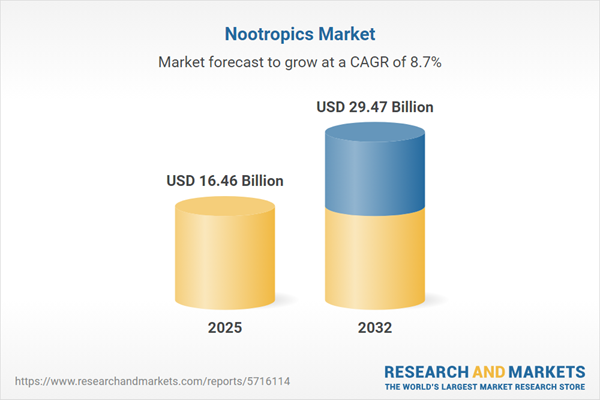Speak directly to the analyst to clarify any post sales queries you may have.
The global nootropics market is experiencing dynamic growth as cognitive enhancers gain traction in a variety of end-user groups, reflecting evolving consumer preferences and innovative product delivery mechanisms. Senior managers monitoring wellness and specialty nutrition trends will find this market's momentum relevant for both strategic investments and competitive alignment.
Market Snapshot: Nootropics Market Size & Growth Trajectory
The Nootropics Market grew from USD 15.13 billion in 2024 to USD 16.46 billion in 2025. Propelled by rising consumer demand for solutions targeting memory, focus, and cognitive well-being, the sector is forecast to expand at a CAGR of 8.69%, reaching USD 29.47 billion by 2032. This trajectory highlights significant opportunities for businesses to capitalize on shifts toward personalized wellness and the integration of digital and retail distribution strategies.
Scope & Segmentation
This report provides a detailed analysis of the nootropics market, examining product forms, distribution strategies, functionality, end-user segments, regional diversity, and active ingredient origins to help guide informed decision-making.
- Product Forms: Covers capsules (including hard and soft gelatin), liquids (dropper and tinctures), powders (bulk and sachet), and tablets (chewable, effervescent, standard formulation).
- Distribution Channels: Encompasses online stores (company websites, third-party platforms), pharmacy retail (chain and independent), and specialty stores (health food stores, nutrition clinics).
- Functional Applications: Addresses energy boosters (natural and synthetic stimulants), focus enhancers (stimulant and non-stimulant), memory enhancers (acetylcholine boosters, racetams), and mood stabilizers (adaptogens, serotonin modulators).
- End Users: Includes adult professionals (entrepreneurs, office workers), athletes (amateur, professional), elderly (60+, 70+), and students (college, high school).
- Ingredient Nature: Differentiates between natural (herbal extracts, vitamins, minerals) and synthetic (amphetamine derivatives, racetams) sources.
- Regions Covered: Americas (North America, Latin America), Europe/Middle East/Africa, Asia-Pacific, with country-level breakdowns for strategic granularity.
- Leading Companies: Evaluates strategies and performance of market participants including Abbott Laboratories, Pfizer Inc., Bayer AG, Danone S.A., Nestlé S.A., Herbalife Nutrition Ltd., Reckitt Benckiser Group PLC, THG Holdings Ltd, GNC Holdings, and Pharmavite LLC.
Nootropics Market: Key Takeaways
- Consumers are shifting toward cognitive health as an integral aspect of daily wellness, fueling increased demand for both natural and synthetic nootropics aimed at mental performance and mood support.
- Product portfolios are diversifying beyond capsules, embracing customizable powder formats, liquid tinctures, and alternative delivery systems that align with evolving preferences for flexibility and convenience.
- Technology-driven advancements in bioavailability, such as lipid nanoparticle and microencapsulation techniques, are enhancing absorption and differentiating offerings in a competitive field.
- Direct-to-consumer models and digital touchpoints are accelerating brand reach, with data-driven personalization supported by wearables and health apps refining consumer engagement.
- Leading players are combining proprietary research, clinical validation, and academic collaborations to improve credibility and foster faster innovation cycles.
- Robust regulatory engagement and transparent supply chain strategies are now essential for maintaining consumer trust and ensuring long-term market positioning.
Tariff Impact and Supply Chain Realignment
Recent trade tariffs, particularly in the United States, have heightened input costs across critical raw materials used in nootropic manufacturing. Industry leaders are actively renegotiating supplier contracts, exploring near-shoring, and adopting risk-sharing partnerships to manage volatility. Ingredient innovation, such as the substitution of cost-effective analogues, is helping to maintain product accessibility and protect margins in an evolving tariff landscape.
Methodology & Data Sources
This report employs a robust multimethod approach including secondary research, primary interviews across regulatory, scientific, and retail domains, and proprietary quantitative surveys. Statistical modeling correlates consumer usage trends with demographic factors, while expert panel validation ensures reliable, actionable insights for decision-makers.
Why This Report Matters
- Enables senior leaders to align product and market strategies with in-depth segmentation, competitive intelligence, and evolving regulatory frameworks.
- Highlights technological and operational trends, supporting evidence-based investment and innovation planning in key geographies and emerging demand segments.
- Equips organizations to anticipate shifts in distribution, consumer behavior, and trade dynamics critical for profit protection and sustainable market growth.
Conclusion
The nootropics market continues to innovate and adapt quickly. Companies that focus on consumer-centric product development, data-driven engagement, and operational resilience will remain well-positioned for ongoing growth and evolving competition.
Additional Product Information:
- Purchase of this report includes 1 year online access with quarterly updates.
- This report can be updated on request. Please contact our Customer Experience team using the Ask a Question widget on our website.
Table of Contents
3. Executive Summary
4. Market Overview
7. Cumulative Impact of Artificial Intelligence 2025
Companies Mentioned
The companies profiled in this Nootropics market report include:- Abbott Laboratories
- Pfizer Inc.
- Bayer Aktiengesellschaft
- Danone S.A.
- Nestlé S.A.
- Herbalife Nutrition Ltd.
- Reckitt Benckiser Group PLC
- THG Holdings Ltd
- GNC Holdings, LLC
- Pharmavite LLC
Table Information
| Report Attribute | Details |
|---|---|
| No. of Pages | 192 |
| Published | November 2025 |
| Forecast Period | 2025 - 2032 |
| Estimated Market Value ( USD | $ 16.46 Billion |
| Forecasted Market Value ( USD | $ 29.47 Billion |
| Compound Annual Growth Rate | 8.6% |
| Regions Covered | Global |
| No. of Companies Mentioned | 11 |









